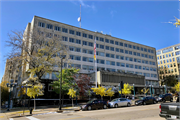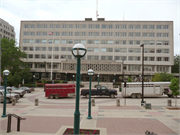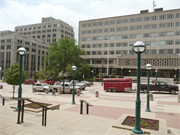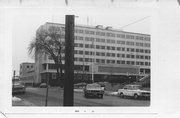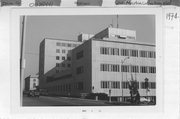Property Record
210 MARTIN LUTHER KING BLVD
Architecture and History Inventory
| Historic Name: | DANE COUNTY COURTHOUSE/MADISON CITY HALL |
|---|---|
| Other Name: | City-County Building |
| Contributing: | No |
| Reference Number: | 28441 |
| Location (Address): | 210 MARTIN LUTHER KING BLVD |
|---|---|
| County: | Dane |
| City: | Madison |
| Township/Village: | |
| Unincorporated Community: | |
| Town: | |
| Range: | |
| Direction: | |
| Section: | |
| Quarter Section: | |
| Quarter/Quarter Section: |
| Year Built: | 1955 |
|---|---|
| Additions: | |
| Survey Date: | 19942019 |
| Historic Use: | courthouse |
| Architectural Style: | International Style |
| Structural System: | |
| Wall Material: | Concrete |
| Architect: | |
| Other Buildings On Site: | |
| Demolished?: | No |
| Demolished Date: |
| National/State Register Listing Name: | Not listed |
|---|---|
| National Register Listing Date: | |
| State Register Listing Date: |
| Additional Information: | DETERMINED NON-CONTRIBUTING IN THE U.S. POST OFFICE DOE 6/21/94. This 1955 building is a good example of the international style. City of Madison, Wisconsin Underrepresented Communities Historic Resource Survey Report: The City-County Building was the location of administrative offices, meetings, and jail space shared by the City of Madison and Dane County throughout the Gay Liberation Movement in Madison. The council chamber on the second floor was the location of the passage of ground-breaking municipal LGBTQ civil rights legislation. LGBTQ groups in Madison gained legal ground in 1975 when the Common Council adopted amendments to the city’s 1963 Equal Opportunities Ordinance. The amendments added sexual orientation to the classes of people against whom discrimination was prohibited. The newly adopted language defined sexual orientation to include “homosexuality, heterosexuality, and bisexuality by preference or practice.” It was the first such municipal ordinance in Wisconsin and one of the earliest in the nation. In 1980, the Dane County Board of Supervisors adopted similar county-wide legislation while meeting in the same room. Jim Yeadon, who was appointed to the city’s Equal Opportunities Commission in the early 1970s and was instrumental in revising the city’s Equal Opportunity Ordinance in 1975, was appointed to a partial term of an open seat on Common Council in 1976; he publicly shared his sexuality the following day. He was then elected to a full term of the Council in 1977, becoming the first openly gay man to be elected to a common council in the country. In the twenty-first century, the LGBTQ community has made significant progress toward the goals of visibility and acceptance in the broader Madison community. However, there was still a struggle for equity in all areas of the law. One of the most important civil rights advancements for LGBTQ people in Madison came in 2014 when United States District Court Judge Barbara Crabb struck down Wisconsin's constitutional ban on same-sex marriage. It was upheld on appeal. Then on June 26, 2015, the Supreme Court of the United States decided Obergefell v. Hodges, a case that granted marriage equality to LGBTQ people nationwide. The first, and many of the earliest, legal same-sex weddings in the state took place at the top of the stairs of the main entrance of the City-County Building after couples obtained their marriage licenses in the Dane County Clerk’s Office, which is also located in this building. |
|---|---|
| Bibliographic References: |
| Wisconsin Architecture and History Inventory, State Historic Preservation Office, Wisconsin Historical Society, Madison, Wisconsin |

